On the Health Benefits of Taking an Arrow to the Eye
My Great-great-great-great-great-uncle John Peery fought in the revolutionary war. His militia did pretty well until the Battle of Guilford Court House, where his son Thomas Peery was killed.
John himself was “frightfully wounded” by a saber blow. According to the accounts, “while prostrate, as Tarleton’s troops passed their stricken foe, each brutal Briton gave him a cut with the saber. He received fifty-four saber cuts so that his head and arms were literally cut to pieces.”
This sounds like the end of Uncle John’s story, but the histories continue, saying, “Despite these severe wounds, he survived and returned to his home on the Clinch River, where he lived a number of years enjoying the freedom for which he had given a gallant son and suffered so much himself.”
Sometimes the human body can take an incredible amount of abuse. But on the flipside, Harold Godwinson, the last Anglo-Saxon king of England, famously caught an arrow in the eye in 1066. Needless to say, he did not survive this calamity.
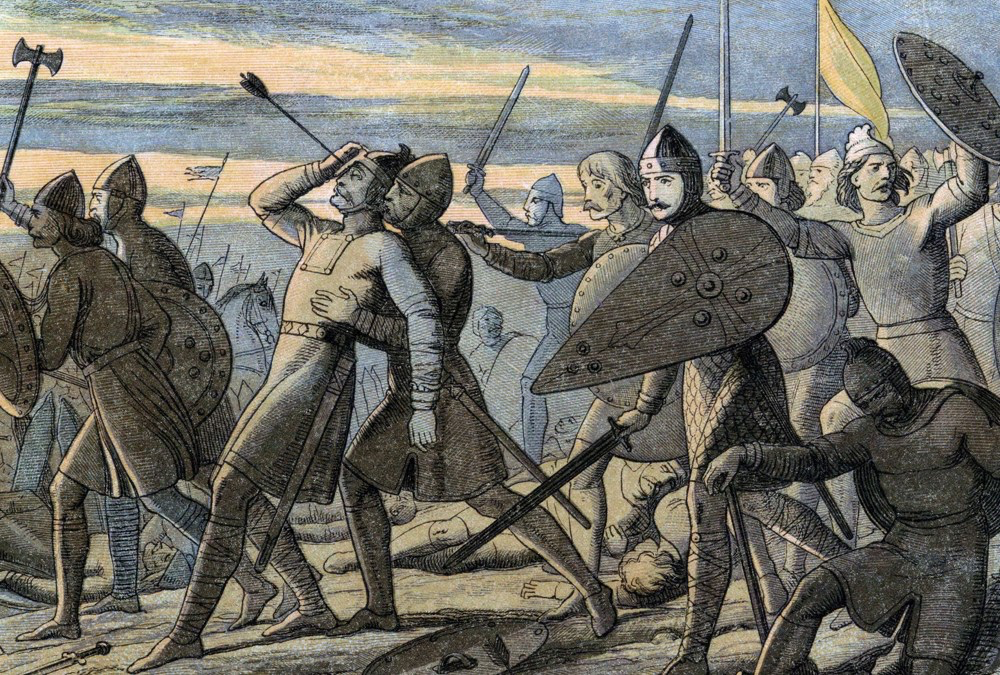
There are a number of common-sense expectations you might have for combat. A skilled fighter should be able to wade into combat without worrying that he’s going to get killed at the first blow. On the other hand, taking an arrow to the eye will kill just about anyone, no matter how tough or experienced they are. Sorry Harold.
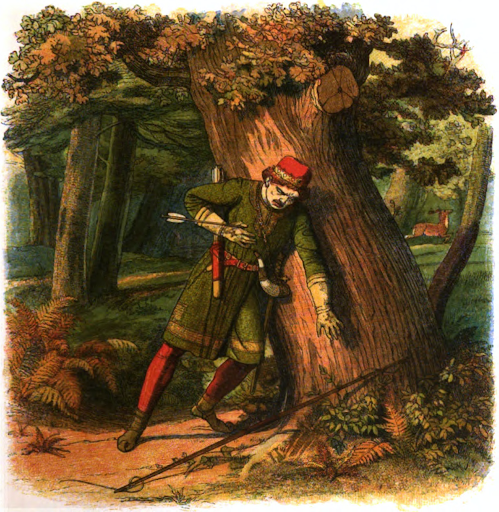
People vary in how big and tough they are, but not by much. Getting stabbed by a spear is less of a problem for a grizzled pro than it is for a fresh recruit, but it’s bad news for everyone.
Even the boldest have something to fear from every attack. Richard the Lionheart died from a single crossbow bolt.
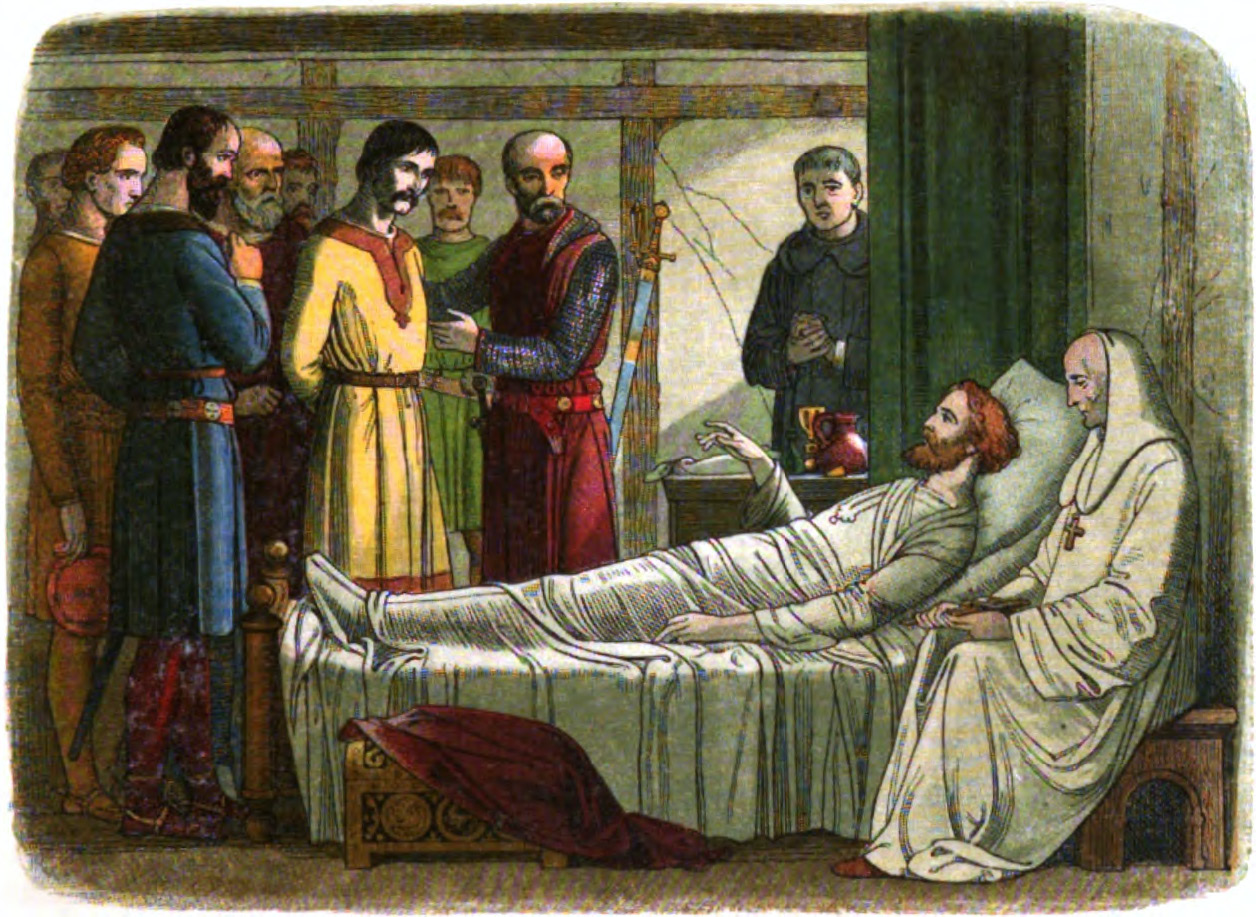
An RPG isn’t obligated to be able to simulate every situation that’s possible in real life. But as Taylor said in his post about resources, we have an intuitive understanding of our physicality and what it means to be injured. When roleplaying systems don’t follow these same rules, it feels strange.
Health systems in RPGs have always felt this way to me. The fiction is all wrong. Great warriors are harder to kill, sure, but not because they can take so many more hits. Taking a couple serious wounds will bring anyone to the edge of death. A pro like Richard the Lionheart survives in combat by having more control over the situation than his opponents. If things go right, he never gets wounded at all. And this is why, when he does happen to get wounded, it might be the end for him. That’s the fiction we’d rather be playing.
Part of the problem is that, at high levels, it feels like you’re not playing for stakes any more. A high level character in most systems knows they can’t die in the first several rounds of combat, so there’s no tension. It breaks the fiction that you’re in a life-or-death struggle. Better to make the stakes high and give more experienced characters more and more control over the situation.
Enter Partial Damage
We’ve been interested in partial damage systems for a while now, because we like how they solve these problems.
The partial damage systems we like have generally been based around the idea that characters have a “toughness” pool, representing the amount of abuse their body can take, and an “awareness” pool (I am making these terms up on the spot) representing their ability to do things like parry, twist out of the way at the last minute, or catch a blow on their armor. Attacks would deal damage to the awareness pool first, until it was exhausted, and damage could be dealt to the character’s toughness.
Very good or lucky attacks — possibly analogous to critical hits — would bypass the awareness pool and deal damage to the toughness directly. And in fact, this revision to the critical hit system is part of why I like this idea so much. A lucky strike isn’t so much one that cuts really deep, it’s one that lands squarely in the first place.
Years ago, we experimented with implementing systems like this in D&D. For example, one approach we tried was dividing up the health pool. In D&D, a character gets a full health die plus their constitution modifier for HP at first level. At each subsequent level, they gain their constitution modifier plus a roll of their health die. A Fighter with a 14 Constitution has a d10 HD and a +2 Con modifier. She would get 12 HP at first level and 1d10+2 HP at every level after that.
We started with the assumption that a first level character has very little ability to defend themselves beyond just tanking blows, and that the hit points from Constitution must represent in some way real ability to weather physical assault. The solution we tried was putting the first level HP, and all subsequent HP from Constitution, into the toughness pool, and putting all the other HP in the awareness pool.
If our fighter rolled a 5 on every HD, then she would have 12 toughness and no awareness at first level, 14 toughness and 5 awareness at second level, 16 toughness and 10 awareness at third level, and so on. While these systems worked in a technical sense, we never really found them satisfying.
Fantastic
When Taylor came up with the Fantastic resource system, we knew that this was the opportunity we had been looking for.
Fantastic doesn’t have a traditional health system. Instead, we tossed it out in favor of resources. One resource, Vitality, plays the star role in this system. At a glance, you might think that Vitality is our health system, but that’s not the case. To a certain extent, all of the resources are your health, but equally, none of them fill that role specifically.
There was a lot of back and forth in the early days of development about whether or not we were making a resource that was also health, or making a form of health that could be used as a resource.

In the end, though, I was wrong and Taylor was right, and we ended up with the system as you see it today, where there is no dedicated health, only resources.
We ended up really liking this approach. Because all of your “health” is expressed in resource cards, it means that damage is covered by the same recovery mechanics that cover all resources. Even when a card is pressed as the result of a hit, you can often recover it. You can think of this system as a partial health bar, with the ability to refill up to a point. This kind of health system is actually somewhat common in video games, especially shooters, but to our knowledge it’s never been tried in pen & paper games (or card games, as it were).
Because resources are also used to pay for actions and abilities, it also means that you’re constantly trading off these options against your health pool. This matches the fiction we’re aiming for really well. Putting your all into one attack or mad dash makes it more likely that you’re going to be distracted or overextended, and end up getting stabbed.
The Cards
Let’s look at the character’s “health pool” from the outside in.
In the broadest sense, all your resources are your health pool. We think this makes a lot of sense; if someone is trying to cut your head off, you’re going to put absolutely everything you have into your efforts to avoid this. You can make use of your toughness, sure, but also your agility, your skill, your awareness, and your cleverness. If any of this will help you, you’re gonna use it.
Of course, your enemy is not going for just any resources. They are probably trying to kill you, so how does it come to happen that these resources are used for health?
In our system, characters can Flinch in response to attacks that aren’t very good, attacks that beat their defense score by a small margin. This action requires you to Burst 3 to avoid taking a Wound. Since that burst cost is totally untyped (you can pay for it in whatever resources you like), Flinching turns all your resources into your first line of defense. You can spend Mental resources to show that you drew on your focus to dodge away at the last moment. You can spend Vigor to show that you used your athletic prowess to narrowly avoid the blow. You can spend anything you have access to. We don’t have magic resources yet, but if we ever do, you’ll be able to draw on them to represent you using your magic to avoid, deflect, or otherwise negate the attack.
If you have enough resources, Flinching is basically free. A character with, let’s say, six different resource cards, can Flinch once, pressing three of them, Flinch again, pressing the other three, and then Recoup, unpressing all their resource cards and returning the full set to the Fresh state, as if nothing had ever happened! A poor character with only two resources, on the other hand, will have to Burn one of them just to pay for a simple Flinch! This is a big way that higher-level characters get “more health” in our system — they can spread these costs out over more resources. We think this is a lot more interesting than just giving them more hit points than the little guys, and it leads to more interesting decision making.
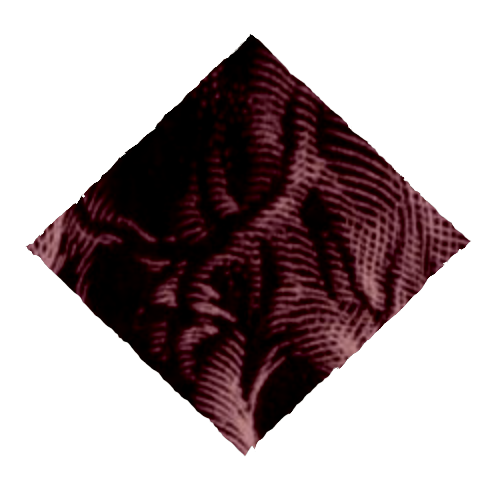
What happens when you do take a Wound (our term for a “true hit”)? Well, a Wound moves you down to the next level in the health hierarchy, that of Vitality. There are different kinds of physical resources, but Vitality is special because it is the currency you pay when you take a Wound. No other resource can take its place. When you take a Wound, you have to Break a Vitality, removing it from play. This represents the fact that you have taken a real flesh wound, and your body has paid the price for it.
Even so, there are often things you can do to mitigate this cost. Let’s say you’re in combat and you have three Vitality (you are a real tough dude). It’s been a tough fight, and one of your Vitality is Burned and pressed, almost broken, but the other two are Fresh. When you take a Wound, you can choose to Break the Vitality that is already Burned and pressed. Taking that Wound means that one of your Vitality has to go, but it doesn’t need to be a Fresh one. Letting the one that’s already a little beaten up Break is equivalent to just Bursting 1, almost cheap! This helps keep the cost down, and is a nice way to even the scales a bit for characters who are already a little beat up.
At the very bottom of the health pool is a very special resource indeed: Vital Flesh. It is the life-preserving element, and every character must have it.
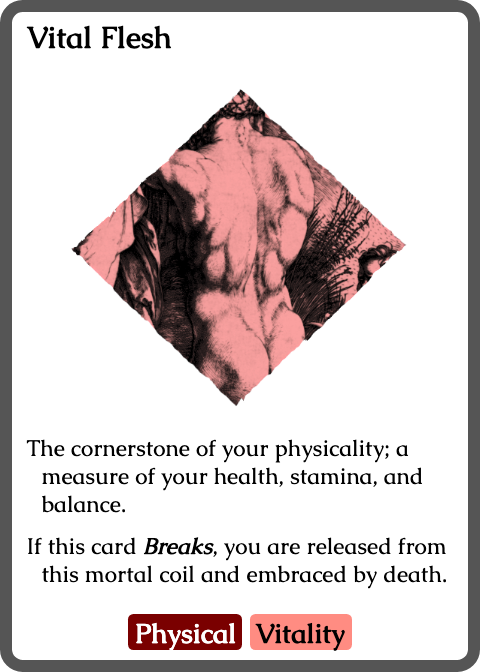
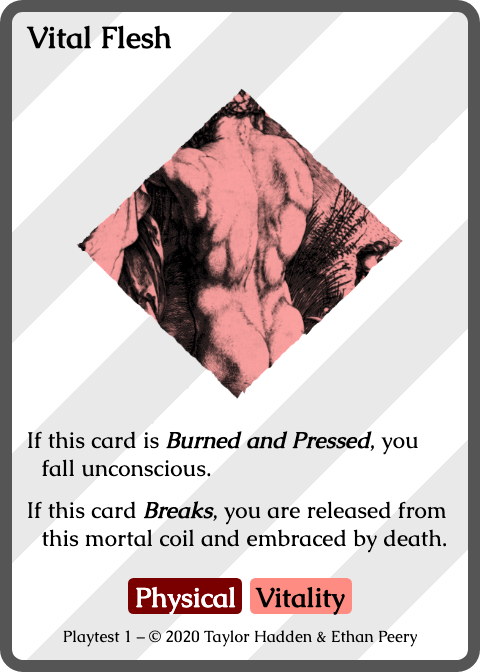
Vital Flesh is, in some ways, the only form of health in the game. It’s the only thing that will save you, and only its absence will kill you. We have simply put lots of barriers in between. To get to Vital Flesh, first you have to deprive the character of all their other Vitality, and to get at those, you either need to wear down their other resources, or get in some exceptionally solid hits.
The way that Vital Flesh works ensures that the coveted one-hit kill is always a technical possibility. Though at present there’s no way for a character to target that card in particular, I’m still glad to have the mechanics acknowledge that at some level, all life is hanging on by a single thread.